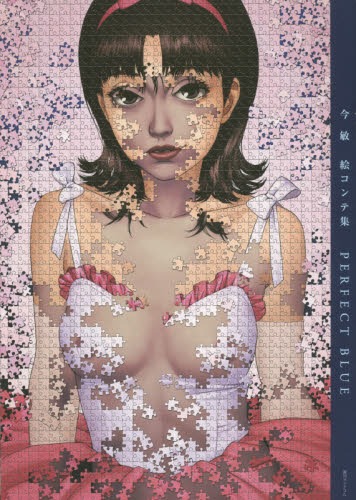
Perfect Blue is a perceptive and surreal look into the life of Mima, a former idol turned actress. With expert directing, courtesy of Satoshi Kon, director of Paprika, Paranoia Agent, and Tokyo Godfathers, the film provides a disturbing look into the entertainment industry and its invasive culture.
Perfect Blue has a biting critique about its subject, pushing into themes about the dangers of mixing public and private personas, the invasive nature of media and its consumers, and how reality can mirror fiction. For this article, I’ll explain how each theme arises through the film’s writing and aesthetic choices, providing a brief look into the surreal work.
Invasion of Privacy: the Mixing of Public and Personal Life
From the start, Perfect Blue establishes a visual trend. As viewers are getting adjusted, the movie transitions back and forth between two scenes: Mima performing at a concert and Mima traveling on a train.
By having both scenes in their respective orders, one can deduce they are related—that Mima is traveling to the concert where she will perform. However, as viewers get further into the movie, we find that these two scenes are first, logically out of order, and second “disconnected.”
Mima is not travelling to the concert but rather travelling to the marketplace to buy groceries, something in her private life. “Simultaneously,” on the stage, she is having her last performance as an idol, stating her wish to pursue acting.
From this point onwards, the film juxtaposes her private and public life until neither are distinguishable. With expert editing, the film using jarring cuts from one scene to another, purposefully disorienting the viewer.
Mima’s privacy is disturbed upon constantly. Some shots are voyeuristic, the photographer’s shots of her nude body is an obvious example. The film uses these shots, not to glorify them, but to create a connection. Due to our proximity with Mima, we also share her emotions and perspective.
However, our proximity is invasively close, and the film doesn’t spend much time away from Mima. Thus, when she gets confused, that confusion transfers to the viewer, accentuated further by jarring transitions. Just as Mima cannot escape prying eyes, the viewer cannot leave her either.
Media and its Role in Shaping Identity
Due to the film’s invasive nature, the film is an example of how the media can influence our perception. To illuminate this idea, the movie focuses on the entertainment industry and its fans.
As a former idol, Mima works with her managers/agents. Part of their job is to guide her and decide which jobs she takes. In doing so, they influence both her life and identity. Her actions as an idol and her actions as an actress, both are not solely her own choice.
The film goes further, invading Mima’s private life. The stalker, an obsessed fan who’s angered by Mima’s change from idol to actress, creates a website called Mima’s Room. Upon visiting the website, Mima is confused, not understanding the implications.
However, Satoshi Kon clarifies for the audience. He shows her life on full display. The scene ends with a shot of a frightened Mima, looking outside her window, the camera zooming back, as if to show someone watching from the outside.
Thus, when the film starts stripping what little choice she has—this literally happens during her first job as an actress—her control over her public and private life spirals out of control. Even though her identity is being molded, she is not the craftsman.
Reality Mirrors Fiction: the Disappearance of the 4th Wall
Once the film has mixed Mima’s personal and private life and taken away her agency, the movie makes a frightening leap into the surreal. Mima’s mental health plummets, her; exhaustion apparent from the multiple deaths surrounding her. Unfortunately, she cannot escape. Her role as an actress becomes a burden, forcing her to mimic real murders. Reality begins to mirror fiction.
In theatrical productions, there are three walls, the back, two sides where actors typically enter, and an imaginary wall. This 4th wall separates the performance from the audience. Logically, if it were to exist, audiences can’t see the play, so this wall is not physical.
However, actors will pretend this wall exists and maintain the illusion that the audience is not there. Nonetheless, some performances will “break the 4th wall,” meaning actors will come into contact with the audience.
When it comes to surreal works, the 4th wall can exist as a safeguard. It represents the line between reality (the audience) and fiction (the story). When the 4th wall is broken, fiction bleeds into reality, sometimes creating an uncomfortable closeness.
In Perfect Blue, the 4th wall is broken, not necessarily for the audience, but certainly for Mima. What she once shrugged off as only acting now makes her uneasy. Mima is uncomfortably close to her TV character, a delusional murderer whose traumatic past split her personality in two. Satoshi Kon capitalizes on this, removing jarring cuts, and melding scenes seamlessly.
By focusing the camera close to Mima, our vision is obscured. By then panning the camera around her, what little we see implies she’s at one location. Continuing, the camera pans until her implied location is obscured and a new one appears. These transitions make it difficult to place Mima’s actual location, mirroring Mima’s sense of being lost. There is even a literal mirror scene, a perfect reflection of Mima chasing herself into “reality.”
Mima’s mental state makes her an unreliable narrator, making it difficult to know where and when the story is taking place. Capitalizing further, character we once trusted are ousted as villains, destabilizing what little we know of the world.
Final Thoughts

Satoshi Kon is a methodical and deliberate. His skill as a director is so evident, one can’t ignore it. As a film, Perfect Blue is an astounding example of surreal fiction, creating poignant commentary about the media and contemporary issues.
I hope this brief look into Perfect Blue has been insightful. While I don’t plan to cover all of Satoshi Kon’s works, I encourage readers to give his works a viewing. There is a myriad of things to learn with each of his films, and even a small look can prove inspiring.
Recommended Post


